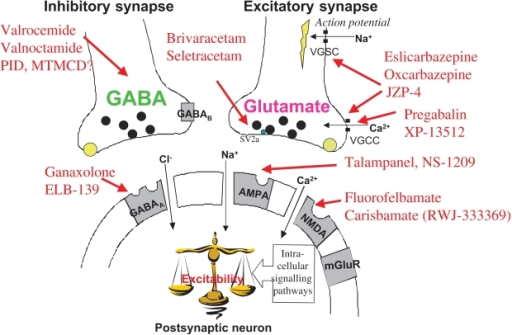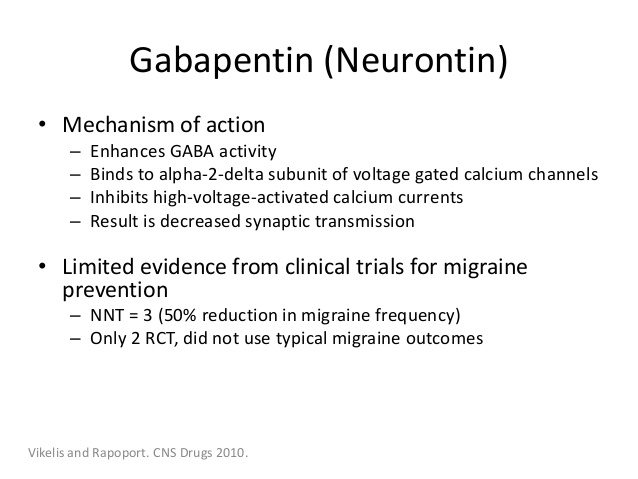The mechanism of the anticonvulsant action of gabapentin has not been fully described. Though similar in structure to the endogenous neurotransmitter GABA, gabapentin has not been shown to bind to GABA receptors at concentrations at or below 1 mM. Gabapentin modulates the action of glutamate decarboxylase (GAD) and branched chain aminotransferase (BCAT), two enzymes involved in GABA biosynthesis. In human and rat studies, gabapentin was found to increase GABA biosynthesis, and to increase non-synaptic GABA neurotransmission in vitro.
Gabapentin (0.01-100 µM) has not been shown to interact with the sodium or L-type calcium ion channels targeted by the conventional anticonvulsant drugs phenytoin, carbamazepine and sodium valproate. Other neurophysiological findings indicate that gabapentin does not interact with glutamate, glycine, or NMDA receptors, further distinguishing its anticonvulsant mechanism from that of common antiepileptic medications.
Gabapentin has no direct GABAergic action and does not block GABA uptake or metabolism. Gabapentin blocks the tonic phase of nociception induced by formalin and carrageenan, and exerts a potent inhibitory effect in neuropathic pain models of mechanical hyperalgesia and mechanical/thermal allodynia.
Gabapentin binds preferentially to neurons in the outer layer of the rat cortex at sites that are distinct from other anticonvulsants. It is likely that gabapentin acts at an intracellular site as the maximal anticonvulsant effect is achieved 2 h after an intravenous injection of gabapentin in rats. This occurs after the plasma and interstitial fluid concentrations have peaked and reflects the additional time required for intraneural transport .
Several theories have been proposed to explain the cellular mechanism of its anticonvulsant effect. The most favoured theory involves an interaction with an as yet undescribed receptor linked with the l-system amino acid transporter protein. Suman Chauhan et al. demonstrated that l-amino acids potently inhibited binding of an␣active enantiomer of gabapentin ([3H]gabapentin). This was further supported by Taylor et al. who showed that the potent anticonvulsant, 3-isobutyl GABA (an analogue of gabapentin) potently and stereoselectively bound to the same receptor. These findings renewed interest in the isolation of the receptor protein that may responsible for this anticonvulsant effect.
Other proposed biochemical events in the central nervous system (CNS) that may explain its anti-epileptic effect include the increased extracellular GABA concentrations in some regions of the brain caused by an increase in activity of glutamic acid decarboxylase that produces GABA, and a decreased breakdown by GABA decarboxylase. Although a study , using magnetic resonance imaging (MRI) spectroscopy showed a global increase in GABA in the brain after the administration of gabapentin, there is no evidence that gabapentin increases intraneuronal GABA concentrations, binds GABAA or GABAB receptors, or exerts any GABA-mimetic action .
Other effects of gabapentin have been described but are not considered to play a significant pharmacodynamic role. These include small decreases in the release of monoamine neurotransmitters (dopamine, noradrenaline and serotonin) and the attenuation of sodium-dependent action potentials (suggesting sodium channel blockade) after prolonged exposure to gabapentin .
The mode of action of gabapentin in the treatment of neuropathic pain has not been fully elucidated. Although early studies indicated that gabapentin had only a central anti-allodynic effect, gabapentin has been shown to inhibit ectopic discharge activity from injured peripheral nerves. The mechanisms of the anti-allodynic effects of gabapentin proposed include: CNS effects (potentially at spinal cord or brain level) due to either enhanced inhibitory input of GABA-mediated pathways (and thus reducing excitatory input levels); antagonism of NMDA receptors; and antagonism of calcium channels in the CNS and inhibition of peripheral nerves.
Of these, antagonism of the NMDA receptor and calcium channel blockade have the most supporting evidence. Field et al. discounted an antihyperalgesic action via opioid receptor binding after demonstrating that morphine tolerance does not alter the efficacy of gabapentin and naloxone does not reduce its antihyperalgesic effect.
Research into a peripheral site of action for gabapentin has produced contradictory results . Intrathecal administration of gabapentin blocks thermal and mechanical hyperalgesia without affecting sympathetic outflow or acute nociception, and this suggests a spinal site of action . Patel et al. demonstrated a presynaptic site of action for gabapentin in the rat spinal cord.
Although gabapentin does not bind to GABAA or GABAB receptors, increased synthesis and reduced breakdown of GABA have been described . Potentiation of inhibitory GABA-ergic pathways seems unlikely to be responsible for its anti-allodynic effect because GABA receptor antagonists do not reduce this effect .
The NMDA receptor complex is a ligand-gated ion channel that mediates an influx of calcium ions when activated. The NMDA receptor complex has a number of binding sites for various ligands that regulate its activity, including the strychnine-insensitive glycine binding site, phencyclidine binding site, polyamine binding site, redox modulatory site and a proton-sensitive site. Partial depolarisation of the neuron after glutamine activation will release a magnesium plug and allow calcium influx into the neuron. These receptors are known to be found in high concentrations in the hippocampus and have been attributed a key role in the process of central sensitisation of painful stimuli, commonly known as the ‘wind-up’ phenomenon, leading to hyperalgesia. Evidence linking gabapentin to the NMDA receptor follows research demonstrating the reversal of the antihyperalgesic effect of gabapentin by d-serine, an agonist at the NMDA-glycine binding site. However, receptor binding studies have failed to demonstrate a direct binding site for gabapentin at the NMDA receptor.
The α2δ subunit of the voltage-dependent calcium channel is a binding site for gabapentin and the S-isomer of pregabolin (S-(+)-3-isobutylgaba). Because only gabapentin and the S-isomer of pregabolin produce antihyperalgesic effects, it is postulated that the antihyperalgesic action for gabapentin is mediated by its binding to this site on the voltage-dependent calcium channel. Fink et al.
showed that, in the rat neocortex, gabapentin inhibits neuronal calcium influx in a concentration-dependent manner by inhibiting P/Q-type calcium channels. The decreased calcium influx reduces excitatory amino acid (e.g. glutamate) release leading to decreased AMPA receptor activation, and noradrenaline release in the brain. These findings support the hypothesis that calcium channel inhibition mediates the analgesic effects of gabapentin in chronic neuropathic pain. A decrease in potassium ion-evoked glutamate release from rat neocortical and hipppocampal slices by gabapentin has been demonstrated.


